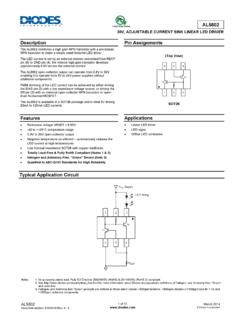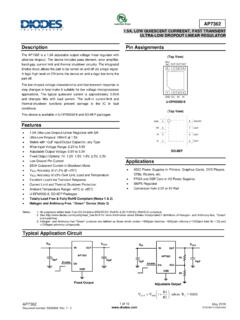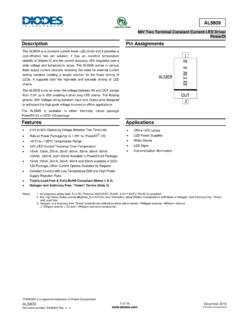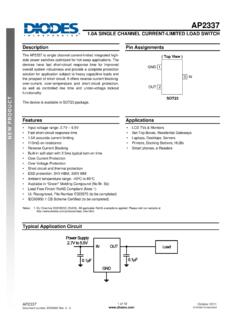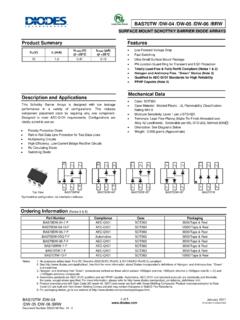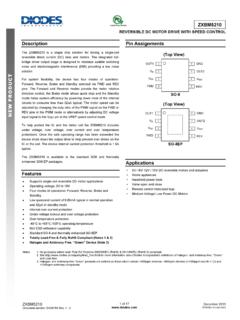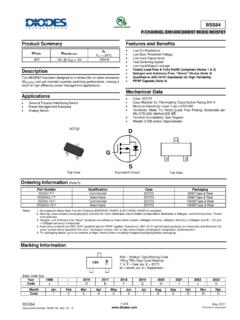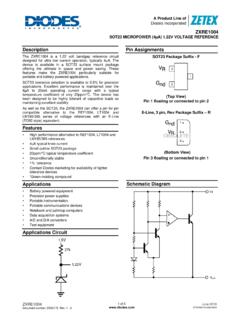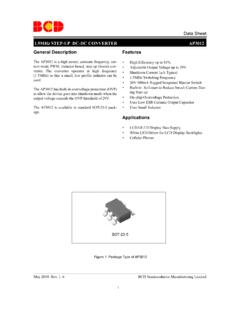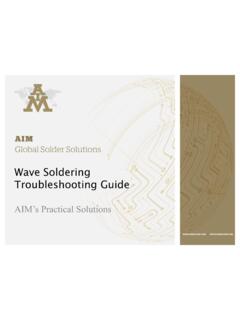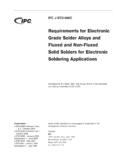Transcription of Recommended Soldering Techniques - Diodes Incorporated
1 Technical Note 1 Recommended Soldering Techniques TN1 - AP02014 Rev. 3 Technical Note 1 of 8 July 2016 Diodes Incorporated Introduction The Soldering process is the means by which electronic components are mechanically and electrically connected into the circuit assembly. Adhering to good Soldering practices will preserve the inherent reliability of the original components and ensure a good, reliable connection of the component into the circuit assembly. Soldering Considerations Substrates: A substrate is a material which constitutes a printed circuit board, commonly called a PCB. There are many different types of PCB substrate materials. Among the most common are the following: Substrate Advantages Disadvantages Phenolic Very inexpensive, easy to punch and drill. Poor resistance to vibration and mechanical shock. FR-4 Inexpensive, moderately easy to drill. Cannot be punched, heavy components need mechanical support.
2 Alumina Good resistance to mechanical shock. Expensive, poor coefficient of expansion match to glass. To select the most appropriate substrate material for the application, the designer of the circuit assembly must weigh these five factors: 1. coefficients of expansion for all the components which will be soldered onto the PCB,2. coefficient of expansion for the substrate,3. cost of the substrate,4. cost of any secondary operations to the substrate, such as the drilling of through-holes , and5. application-specific issues, such as vibration resistance and is important to match the coefficients of expansion for the components to those for the PC board. When a PCB assembly is soldered and the coefficients of expansion for the components and the PC board are not matched, the solder joints may crack or the bodies of the parts may crack or shatter as the assembly cools. Fig. 1. Axial-Leaded Components Fig.
3 2. Surface Mount Components TN1 TN1 - AP02014 Rev. 3 Technical Note 2 of 8 July 2016 Diodes Incorporated PCB Pad Layout and Solder Paste Thickness: It is important to use proper layout patterns in order to ensure good solder connections, especially for surface mount components soldered by a reflow process. Many surface mount components have more than three terminals which form the footprint for the devices. Ideally, every terminal of the device would be formed to create a perfect mounting plane. In the real world, there is a tolerance associated with how close each lead comes to meeting the intended plane. A measure of this characteristic is called coplanarity. In most cases, some of the terminals of a device will not be perfectly aligned with the intended mounting plane. In an infrared reflow solder process, the PCB pads are coated with a solder paste (Figure 3). When the assembly is heated in an oven, the solder paste warms and reflows.
4 As the solder paste liquefies, it forms an apex at the center of the PCB pad. This apex must contact the terminal of the device in order to make contact. When using an IR reflow process, the solder process engineer must take into account the pad layout and the coplanarity of the devices when determining the solder paste thickness. Figure 4 shows a failure mode where the device has poor coplanarity and the solder paste thickness is insufficient for the apex of the liquefied solder to contact the poorly formed terminal. Care must also be taken not to use too much solder paste. Excessive solder paste will result in too much solder on the pad. The terminals of many surface mount components are designed to flex, which allows the terminals of the component to withstand mechanical and thermal stress without fracturing. When excessive solder is applied, the terminals become captivated within the solder and force is transferred away from the terminals and into the internal structure of the device.
5 This can lead to immediate or latent failures. Figure 5 shows a solder connection with the proper amount of solder and figure 6 shows excessive solder. Fig. 3. PCB With Solder Paste Before Component Insertion and Reflow Fig. 4. Device Exhibiting Poor Coplanarity Fig. 5. A Good Solder Connection Fig. 6. Excessive Solder TN1 TN1 - AP02014 Rev. 3 Technical Note 3 of 8 July 2016 Diodes Incorporated Fluxing and Cleaning: Another major consideration in Soldering is fluxing. Flux, used in conjunction with solder during the Soldering process, is the material that aids the solder in flowing. The selection of the proper flux and its correct application are essential to proper Soldering . Fluxes have differing levels of activity, or abilities to remove contaminants from the device terminals and PCB pads. A key characteristic of fluxes is their solubility. The solubility of the flux determines which wash processes can be used to remove the flux.
6 In the past, many circuit assembly facilities used active, non-water soluble fluxes. Active fluxes are able to remove surface oxides from the leads or terminals of the devices and result in even, smooth solder joints with excellent wettability. However, active fluxes are highly corrosive. When active fluxes are not completely removed, the solder joints are more likely to corrode and the long-term reliability of the assembly may be degraded. Active fluxes must be removed from the PCB. The removal process is called cleaning or washing. Many materials which are highly effective at removing flux (such as freon and trichloroethane) became subject to environmental legislation several years ago, and they are now illegal in environmentally-conscious countries. As a result of these concerns, the following two trends have emerged: circuit assemblers have migrated to low activity fluxes. Fluxes are available now which have suchlow activity levels that it is not necessary to remove them from the PCB.
7 Such fluxes are commonlyreferred to as no-wash leave-on fluxes. However, low activity fluxes frequently lead to wettabilityproblems. Wettability is a measure of how well the solder joins the device lead or terminal to the PCboard (Figure 7). Two important factors in a low-activity flux process are the cleanliness of the deviceleads or terminals, and the plating thickness of the leads or terminals. If the terminals of a device arenot sufficiently clean, dewetting can occur. If the plating thickness of the device terminals is insufficient,non-wetting can occur. De-wetting: Fluxes with low activity levels are not as effective at removing oxides and contaminantsfrom device leads or terminals as active fluxes. When contaminants are not properly removed fromthe pads and/or the leads of the devices, de-wetting can occur. De-wetting is characterized byirregular and dispersed solder droplets on the joint surface, often separated by a thin layer of solderbetween them.
8 Non-wetting: Solder may not adhere to the leads or terminals of a device if the plating thickness istoo thin. This problem especially applies to axial-leaded devices since the solder must bridgeacross the through-hole from the pad to the lead (Figure 8). to the aforementioned concerns pertaining to low activity fluxes, the electronics industry hasdeveloped highly active fluxes which are water soluble. These new types of fluxes offer theeffectiveness of a highly active flux in conjunction with water-solubility for ease of 7. A Solder Joint Exhibiting Good Wetting Fig. 8. Non-wetting Solder Joint TN1 TN1 - AP02014 Rev. 3 Technical Note 4 of 8 July 2016 Diodes Incorporated Plating Composition: The leads or terminals of components usually consist of either copper, a copper alloy, or other alloys such as dumet. The leads are plated with one or more other metals.
9 Three common plating materials are tin, lead, and silver. The composition of the plating material directly affects the solderability of the device. When an alloy is used for plating, the temperature at which it transitions from its solid to liquid state is called the eutectic temperature. Many axial-leaded components are plated with either 100% Tin (Sn), or 90% Tin (Sn)/10% Lead (Pb). 100% Tin has a melting point of approximately 232 C, and 90Sn/10Pb has a eutectic temperature of approximately 216 C. Many surface mount components are plated with an alloy of 60% Tin, 40% Lead (Pb), which is eutectic at approximately 190 C. The eutectic temperature of the plating alloy determines the minimum limit of the Soldering process temperature in order to reflow the plating on the device s leads or terminals. Body Composition: The body composition of the devices is also pertinent to the Soldering process.
10 The body material of many components consists of plastic epoxies, which can be grouped into two main categories: Thermoplastics: Thermoplastics can be melted and remolded more than once. One such body material iscalled Thermoplast, which melts at around 280 C. Thermoplast has a melting temperature which isrelatively close to the eutectic point of the plating on their leads or terminals. Solder process engineersshould make sure that the peak Soldering temperature does not exceed the melting temperature of anythermoplastic-bodied devices. Thermosetting plastics: In contrast to thermoplastics, thermosetting plastics, such as Duroplast, are formedonly once. Subsequent exposures to high temperatures (such as those in the range of most solderprocesses) cause the material to harden instead of soften. Exposure to excessively high heat causes athermosetting plastic to crack or Methods and Process Stages Soldering methods commonly used today include: Wave Soldering : Wave Soldering is still widely employed for axial leaded devices and for mixed technologyboards.
